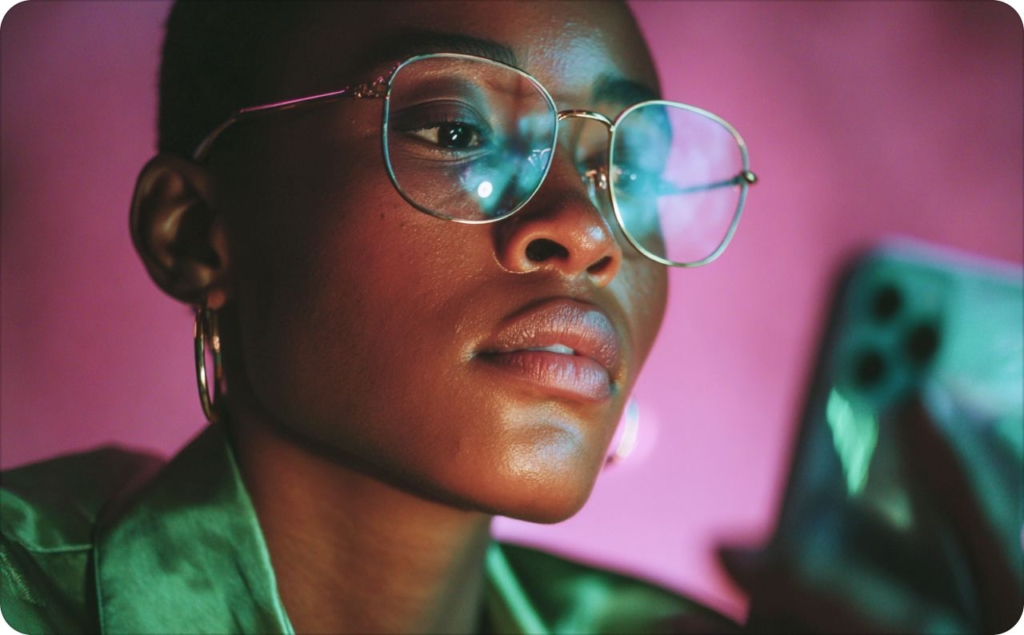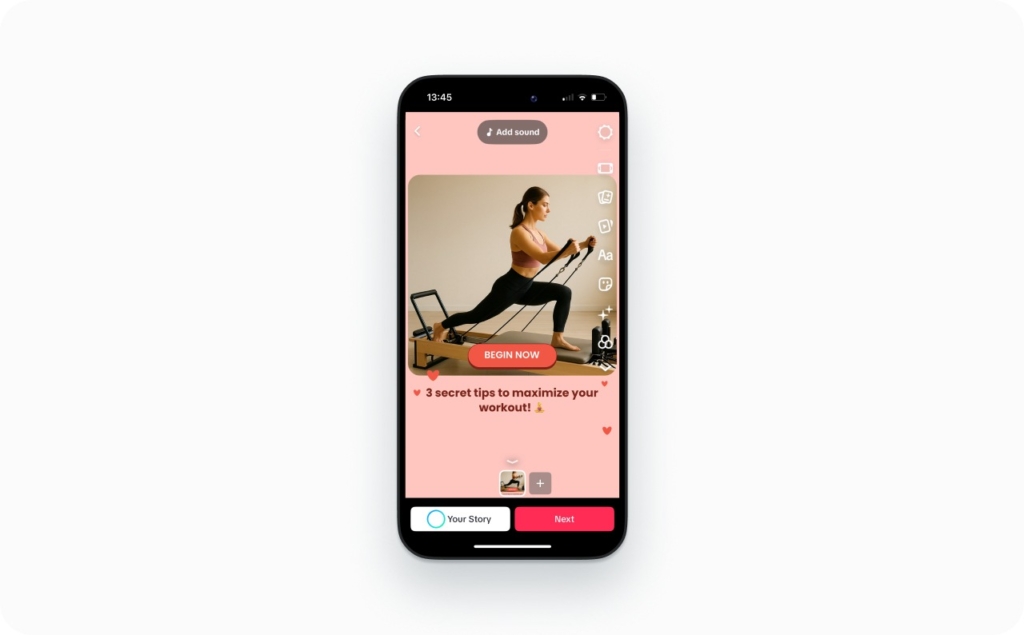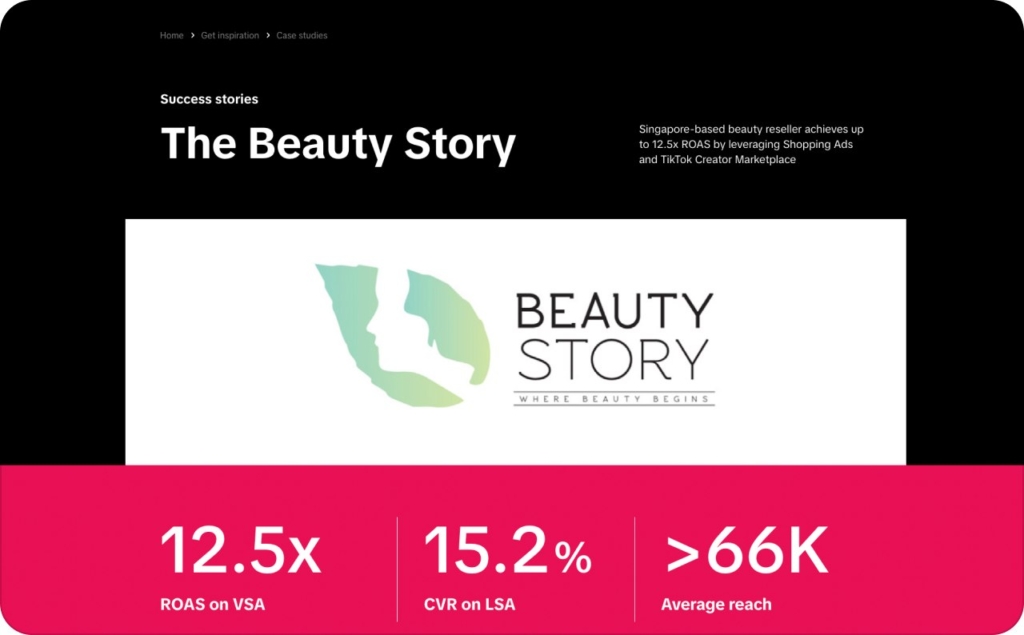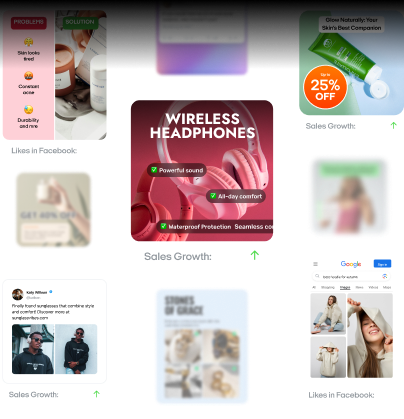5 hooks for TikTok video ads that help small businesses get more engagement
TikTok ad hooks every small business owner needs! Learn how to capture attention, boost views, and drive real engagement.
On TikTok, grabbing attention within the first few seconds is everything. A TikTok hook stops the scroll and captivates viewers instantly. Whether it’s a bold statement, question, or curiosity trigger, your hook is key to standing out. Without a strong hook, your content rcan get lost in the feed.
TikTok’s algorithm rewards engagement, with strong hooks driving better performance. TikTok for Business reports that 63% of videos with the highest CTR engage viewers within the first three seconds. A good hook not only captures attention but also boosts viewer retention and conversion rates.
Creating a strong hook is about more than being catchy — it’s about connecting with your audience’s emotions or curiosity. A great hook encourages viewers to take action, like liking, sharing, or following a CTA. In this guide, we’ll cover the most popular TikTok hooks, how to use them, and why they work.

Use strong hooks in your TikTok ads to get more views and conversions
A TikTok scroll stopping hooks grabs the viewer’s attention and stops the scroll. Without a strong hook, your message gets lost, wasting your ad budget and limiting reach. A weak hook leads to low engagement, poor conversions, and fails to impress TikTok’s algorithm, which is essential for effective ad distribution.
A successful hook works by tapping into psychological triggers that immediately engage viewers. It appeals to core human emotions like curiosity, urgency, and the need for quick value. These triggers are backed by behavioral science in marketing. A well-executed hook gets the viewer to pause, think, and keep watching.
Beyond grabbing attention, hooks are the foundation of conversion mastery. When a hook works, it leads to longer watch times and faster interactions. This boosts your ad’s performance, making TikTok’s algorithm more likely to distribute your content widely, all while lowering cost per acquisition.
If you’re looking to improve your ROI on TikTok, fine-tuning those first few seconds is essential. Using ad psychology effectively and leveraging proven hooks isn’t just an option — it’s the key to success.
What hooks you should use to get better results
Choosing the right TikTok video ad hook types can determine whether your ad resonates with your audience or fades into the background. Understanding how TikTok video openers function will help you create scroll-stopping hooks that enhance video engagement and improve ad performance metrics.
UGC hooks that sell on TikTok grab attention within the first 3 seconds and instantly spark curiosity or relatability. Effective hooks often start with a bold statement, a problem, or a direct callout. What works best is authenticity — people want to see real reactions, transformations, and honest storytelling. The more raw and personal the hook feels, the more likely it is to convert viewers into buyers.
Crafting an engaging hook is essential to ensure your content stands out in those critical first moments. Effective attention grabbers transform casual viewers into engaged prospects, boosting your CTR and conversion rates.
1. Use question hooks to spark curiosity and keep viewers watching
A question hook grabs attention by posing a thought-provoking question, sparking curiosity. Starting your TikTok video ad with a provocative question creates a curiosity gap, encouraging viewers to stay for the answer. This increases engagement and leads to higher viewer retention rates.
A well-crafted question establishes a direct connection with the viewer, making the ad feel more like a conversation than a broadcast. For instance, a question like “Are you ready to change the way you manage your finances?” immediately speaks to a common problem, encouraging the viewer to stay and learn more.
To design a successful question hook, pinpoint your audience’s key concerns or aspirations. Then, create a question that directly addresses those needs. Test these hooks with A/B split testing to refine the language and context that garners the most interaction.
2. Grab attention fast by using negative or bold hooks
Negative & taboo hooks grab attention through shock value, controversy, or unconventional perspectives. They evoke strong emotional responses by tapping into surprise and rebellion. However, these hooks must be used carefully to avoid alienating your audience.
When using negative & taboo hooks, the key is finding balance. These bold statements can lead to higher engagement, but they must still align with your overall message.
For example, a skincare brand could say, “Stop making this common mistake that’s ruining your skin!” This statement points out a problem while positioning the product as the solution.
To use this approach effectively, it’s important to understand your audience’s boundaries and your brand’s risk tolerance. While some brands may thrive on edgy content, others need to be more cautious.
Ensure that the taboo advertising element supports your message rather than merely shocking for shock’s sake. Track audience segmentation metrics and analyze feedback to ensure the strategy aligns with your brand’s goals.
3. Tell personal or controversial stories that help viewers trust your brand
To establish a deeper connection with your audience, controversial & personal experience hooks can humanize your brand. If your messaging feels too generic, these authentic hooks let you engage viewers by sharing personal stories or addressing hot-button issues. Sharing real experiences builds trust and relatability.
When combining controversy and personal stories, the goal is to create a balance that resonates with viewers. For example, a fitness brand could begin with: “My biggest fitness mistake was…” and then share how their product helped solve the issue. This sparks conversation, builds trust, and connects with the viewer emotionally.
To share a personal story effectively, tie it to your brand’s values and position your product as the solution. Authenticity is key — use techniques like behind-the-scenes insights for credibility. Measure success by tracking consumer trust metrics like viewer retention and engagement.
4. Try using lists, surprising facts, or curiosity to make people stay
List, fact/number & curiosity hooks are excellent for presenting information in a clear, digestible format that engages viewers while establishing credibility. Many marketers miss the opportunity to present facts or data that immediately capture attention. These data-driven hooks make viewers eager to stay and learn more.
To improve engagement with list or fact-based hooks, present surprising statistics or promises upfront. For example, “3 secret tips to maximize your workout!” or “Did you know 80% of small businesses fail because of…?” These hooks immediately create a curiosity gap, encouraging viewers to stick around.

When using list hooks or curiosity hooks, ensure your data is both accurate and surprising. Make your facts intriguing and aim to fill an information gap that keeps viewers engaged. Visual elements, such as on-screen text or bullet points, can help reinforce the message, ensuring clarity and enhancing engagement.
5. Use FOMO or price hooks to get viewers to act right away
To drive conversions, fear of missing out, price & alternative hooks create urgency and prompt viewers to act. These hooks rely on the psychological triggers of scarcity and exclusivity, compelling viewers to act quickly. However, the challenge is to generate urgency without sounding overly sales-driven.
FOMO hooks work by tapping into the fear of missing out. Phrases like “Limited stock left!” or “Last chance for 50% off!” immediately create urgency. Similarly, Price hooks such as “Exclusive deal today!” or “Only $29 for today!” provide clear incentives that push viewers to take action without delay.
To create urgency, use visual cues like countdown timers or clear calls to action. For alternative hooks, highlight your offer’s unique value. Use A/B testing and performance metrics to refine hooks and identify which ones drive the most conversions for your audience.
6. Use AI to pick the best hook for your video
When it comes to AI TikTok ads, strong hooks are key to grabbing attention and driving conversions. AI tools can analyze top-performing content and suggest hook variations based on current trends, audience behavior, and emotional triggers. Whether it’s “I asked AI to find the best skincare product — and it actually worked” or “This AI tool picked my outfit — here’s how it went,” combining curiosity-driven hooks with AI-generated insights makes your content feel fresh, personalized, and built for virality.
How you can create TikTok hooks that grab attention and bring results
Strong TikTok video ad hooks capture attention in the first seconds. On TikTok, users decide whether they’ll keep watching within just 1-2 seconds, making your hook crucial to success.
Mastering how to write TikTok ad hooks will significantly improve your ad performance. These attention grabbers capture interest and encourage viewers to become customers.
Step 1: Brainstorm scroll-stopping hooks
Begin by generating a batch of 10–15 hook ideas per campaign. Focus on what matters most to your audience: their frustrations, needs, and motivators. Every TikTok hook should connect to these emotional or practical drivers.
Explore viral TikTok hooks to observe trending themes, sounds, and visuals. Adapt what fits your product. For niche categories, use customer questions or objections as inspiration. Hook ideas can also come from reversing bad ones — write the worst hook possible, then reshape it into something watchable.
Capture and sort ideas using a simple brainstorming sheet. Group hooks by emotional tone, style, or intended outcome to streamline testing later.
Step 2: Refine hooks with copywriting techniques
After drafting hook ideas, refine the best ones using copywriting structures and emotional cues. Place your hook in the first second and keep it under 5 seconds. This maximizes your odds of catching attention before viewers scroll.
Match the tone and language to your audience’s age, habits, and communication style. A hook aimed at younger users needs different pacing and phrasing than one targeting professionals. Use words and visuals that feel familiar to your target group.
Effective formats include:
- Highlighting a problem with a hint of resolution: “Struggling with dry skin? This changed everything.”
- Creating urgency through limited availability: “Only 3 left in stock — don’t miss out.”
- Challenging assumptions with surprise: “You’ve been brushing your hair wrong your entire life.”
Blend visual and verbal hooks when possible. Fast edits, text overlays, or reaction shots layered with voice or captions increase viewer engagement.
Two reliable structures include:
- PAS: Problem, Agitation, Solution
- AIDA: Attention, Interest, Desire, Action
Use these to organize your script around momentum and clarity.
Step 3: Test and optimize hook performance
Great hooks still need validation. Use A/B testing to compare variations. Duplicate your ad and change only the hook in each version. Send both to similar audiences.
Run each variation long enough to gather reliable data — typically 3–5 days. Focus on key metrics:
- Click-Through Rate — aim for 1.5% or higher
- 3-second view rate — target 35%+
- 2-second hook hold rate — ideal is 35%+
Use TikTok Ads Manager for campaign setup. For basic testing, UTM tracking with Google Sheets works well. Once a clear winner emerges, identify what made it successful — emotion, phrasing, or format. Apply those insights to your next round. Repeating this process improves future conversion hook performance.
By applying this process, you’ll create TikTok hooks that capture attention and drive action — no guesswork required. Clear thinking, fast testing, and tight storytelling are your best tools for growth in short-form ad creation.
What you should and shouldn’t do when writing TikTok hooks that work
TikTok ad hooks are the make-or-break moment of your video. Strong first impressions matter. Getting this right helps reduce wasted ad spend and ensures your creative lands with real viewers.
What You Can Do to Make Your TikTok Hooks Get More Views
To get people to stop scrolling, your hook needs to catch their eye in the first second. These proven tactics will help you stand out and keep viewers watching longer. Use them to spark interest, build trust, and increase your chances of clicks and conversions.
1. Start strong by grabbing attention right away
Your TikTok hook should appear immediately — within the first second — and run no longer than five seconds. That’s your window to stop the scroll. Use direct language, bold visuals, or action-driven scenes to immediately communicate value.
2. Show something moving fast to make people stop scrolling
Dynamic cuts, before-and-after sequences, and product transformations are examples of visual hooks that demand attention. A cleaning product ad that shows the result upfront often outperforms one that builds slowly..
3. Use TikTok trends that make sense for your business
Use trending sounds, editing formats, or pacing — but make them relevant. If your brand doesn’t align naturally with trending memes or audios, mimic the structure or rhythm instead. A beauty brand can use a trending “Get Ready With Me” format while showcasing its own unique tone and product flow.
4. Use emotion that connects to what you’re selling
Emotional hooks perform best when they lead into something concrete. Curiosity, surprise, or urgency are powerful, but they must point to a product truth. A financial advisor opening with “Did you know 70% of people struggle with budgeting?” drives immediate relevance by connecting emotion to value.
5. Talk to the viewer like you’re speaking just to them
Address the viewer directly. Use “you” language to create connection. A line like “This product will change your routine” doesn’t just personalize — it creates tension and invites curiosity. Combine verbal delivery with visual cues like text overlay, eye contact, or facial expression, to deepen the effect.
For illustration, a reseller The Beauty Story, used fast-paced TikTok videos with a strong opening hook and a clear CTA encouraging actions like checkout or payment. This led to a 12.5× ROAS on Video Shopping Ads, and a 15.2% conversion rate. The campaign reached over 66,000 users, driving 12.8K engagements and 3.4K profile visits.

Photo source: TikTok
What you should avoid so your TikTok hook doesn’t fail
Some mistakes can cause viewers to scroll past before your ad even begins. Knowing what to avoid can save you money and boost your chances of success. These common pitfalls hurt engagement, but they’re easy to fix once you spot them.
1. Don’t start with a boring intro
Bland intros like “Hey guys” or “Welcome to our page” often result in fast drop-off. These lines feel passive and forgettable. Instead, start with an immediate hook to capture your audience’s attention in the crucial first few seconds.
2. Don’t start your video with too much stuff
Don’t overload your viewer with competing visuals, copy, or transitions. A crowded intro weakens clarity. Focus on a single message or value point. Simplicity keeps your viewer focused and improves comprehension, especially in vertical fast-scroll environments.
3. Don’t push a sale right away
Avoid pushing “Buy now!” or “Limited-time offer!” in your opening. This type of direct pitch often triggers resistance. Instead, build interest first, then layer your call-to-action after the hook has done its job.
4. Don’t say overused phrases
Avoid stale marketing phrases. Slogans like “Best in class” or “Game changer” are easily ignored. Today’s viewer is fluent in digital content — originality signals authenticity. Rewrite old lines with your product’s real tone or user language.
5. Don’t trick viewers with clickbait
Hooks that overpromise and underdeliver damage your brand and inflate your CPV. Misleading statements not only disappoint viewers but can also push your ad into negative relevance scores. TikTok’s algorithm tracks early exits, which hurt future reach. Your hook must align with the value the video actually delivers.
These aren’t hard rules — they’re patterns that underperform in most cases. TikTok rewards creative risk when it’s backed by data. Use A/B testing to validate edge cases. Sometimes a disruptive or unorthodox hook wins, but it must be tested carefully.
Mastering TikTok ad hooks requires more than just creativity — it takes precision, testing, and consistency. Keep refining your delivery, adapting trends to your brand, and aligning your message with what your audience actually cares about. The hook is your ad’s front door — make it impossible to scroll past.
Start using better TikTok hooks right away
Creating a compelling TikTok video ad hook is just the beginning. Now that you understand the power of effective hooks, the key to success lies in strategic execution. The right hook can transform your TikTok ad campaign, turning passive viewers into engaged customers.
To keep the momentum going, start testing different hook types and measure their impact on your engagement and conversion rates. Continuous learning and experimentation will lead to more effective ads, improved performance, and ultimately, a higher return on investment.
For the next step, take action by exploring testing tools and resources to refine your hook strategy. Whether it’s through A/B testing or analyzing performance metrics, consistently optimizing your approach ensures you stay ahead in the fast-paced world of TikTok advertising.
Also recommended



